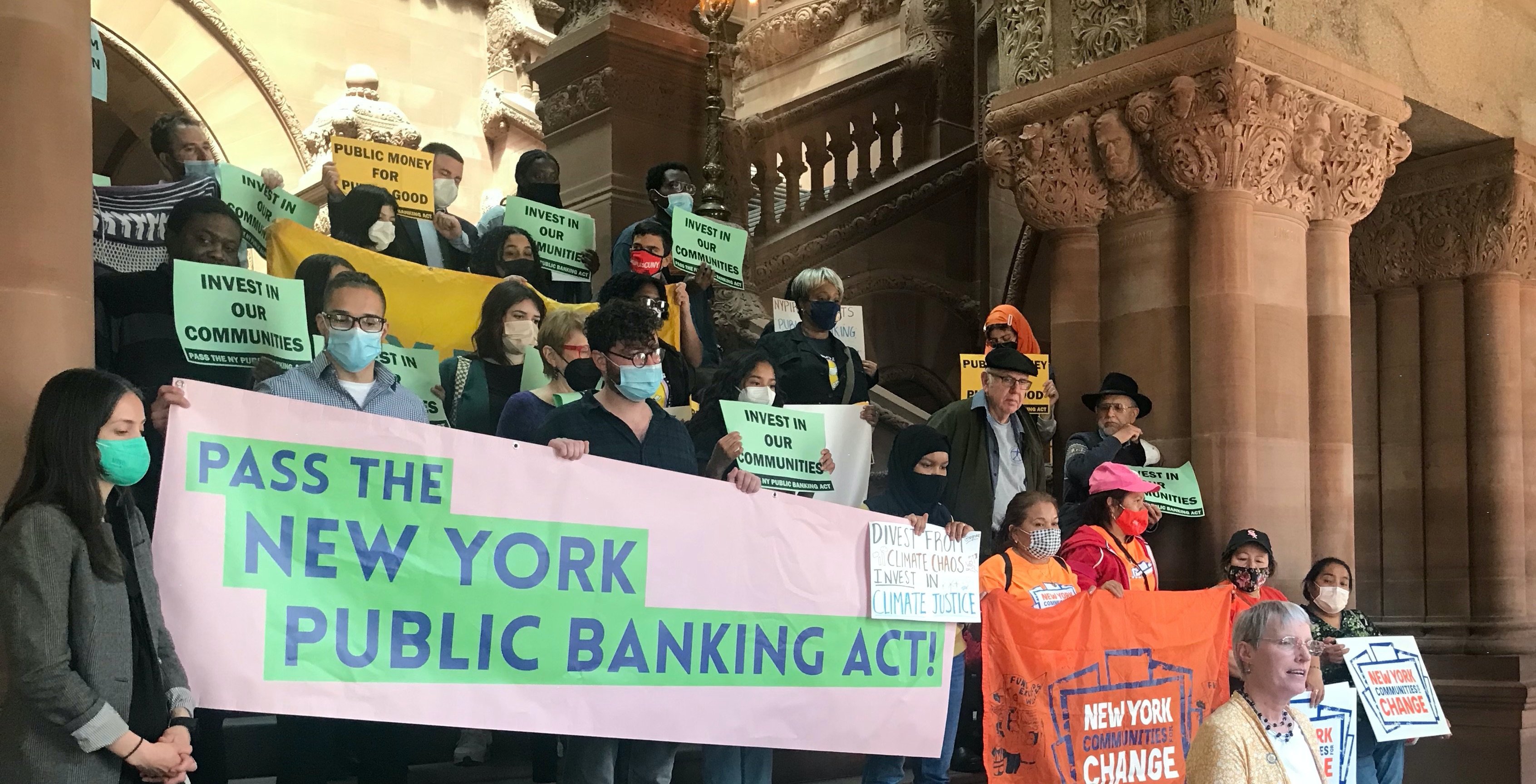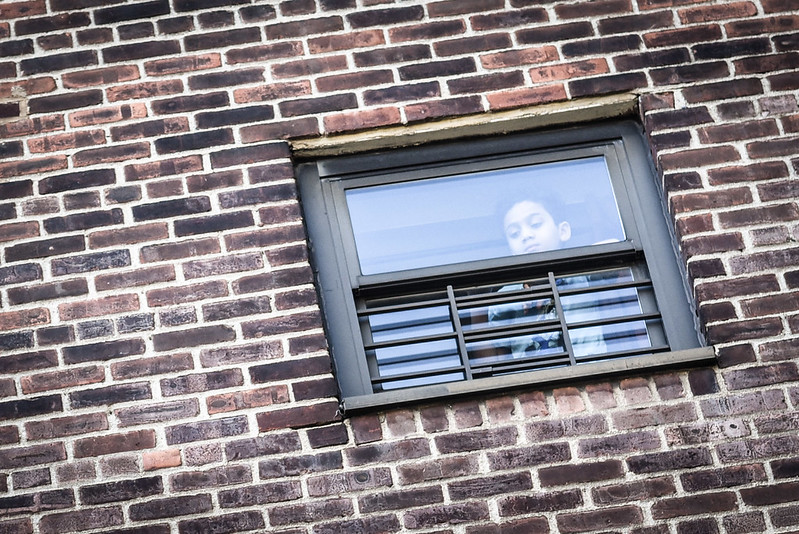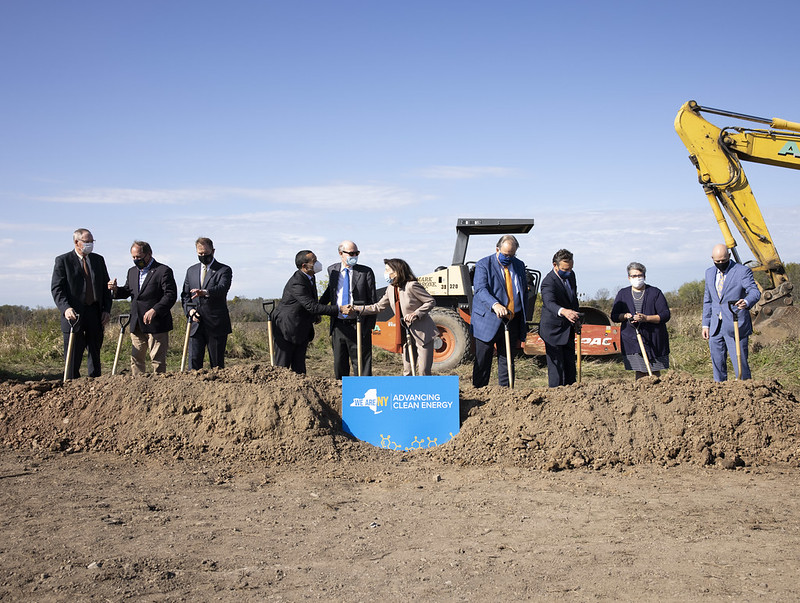To Achieve Real Financial Accountability, New York City Needs a Public Bank

The push for public banking (photo: @PublicBankNYC)
Here’s something that might surprise you: Almost all of the $100 billion in revenue New York City will collect this year to pay for schools, buses, and other public services will be deposited in three big banks – JPMorgan Chase, Bank of America, and Citi. That’s because New York State requires local governments to put our public funds in banks, essentially handing Wall Street a lucrative monopoly that it has lobbied to uphold for more than a century.
Talk about easy money. We give big banks our public dollars, from which they profit handsomely, and New York City gets no meaningful commitments from them in return. It’s time to change the way the City does its banking and use our considerable leverage to ensure that public money works for the public good.
The City has begun taking steps in the right direction. New measures by Mayor Eric Adams and Comptroller Brad Lander aim to hold the City’s designated banks “more accountable to the public,” and will bring needed sunlight to the NYC Banking Commission. The Commission, a three-member body, composed of the Mayor, Comptroller, and Commissioner of Finance (a mayoral appointee), is charged with designating which banks are eligible to hold City deposits.
Now, when banks apply for designation, the Commission will require that they submit detailed plans to prevent lending and employment discrimination in their operations. The Commission also will, for the first time, open up the designation process to public comment and testimony.
The City’s recent decision to cut ties with Wells Fargo helped spur the Commission to revamp its designation process, according to Comptroller Lander. In fact, New York City’s bumpy relationship with the scandal-ridden bank is a case in point of how compromised we are when we entrust our public money to Wall Street.
In 2017, environmental and indigenous rights activists called on the city to ditch Wells Fargo amid nationwide protests of the bank over its financing of the Dakota Access Pipeline, which threatened the ancestral land of the Standing Rock Sioux tribe. At the same time, regulators had slapped Wells Fargo with a rare and long overdue downgrade of its Community Reinvestment Act rating, following the bank’s notorious “fake accounts scandal” – giving the City the legal hook it needed to begin drawing down its accounts with the bank. But the Banking Commission never formally removed Wells Fargo’s designation, and by 2021 the City had welcomed the bank back into the fold.
That is, until last summer, when Wells Fargo was exposed, yet again, for lending discrimination, this time against Black homeowners seeking to refinance their mortgages. Public Bank NYC, a citywide coalition of more than 40 community and labor groups, demanded that the City cut ties with the bank, and two weeks later, Mayor Adams and Comptroller Lander did just that.
Thanks to the dogged efforts of Public Bank NYC and others, the New York City Banking Commission is now in the spotlight. New Yorkers are gaining greater awareness that where we bank as a city has profound public policy implications.
Imagine if the City deposited our public dollars in a bank dedicated to advancing racial, economic, and environmental justice.
With a public bank, created by the City and chartered to serve the public interest, we can ensure that public funds are managed accountably for the benefit of all New Yorkers. It would enable the City to leverage billions of dollars toward investments in affordable housing, small and worker-owned businesses, renewable energy, and other critical needs in low-income, Black, brown, and immigrant communities that the big banks routinely fail to serve.
The City Council is primed to act. A supermajority of Council Members supports “The People’s Bank Act,” a legislative package that lays the foundation for a public bank. For starters, the People’s Bank Act would require that the City publicize quarterly summaries of its accounts with designated banks, including account balances and fees charged. This measure would ensure transparency, now missing, regarding the City’s bank deposits, and help New Yorkers assess the scale of deposits available for a public bank. Another bill in the works would establish a working group to guide the creation of a business plan and draft articles of incorporation for the public bank.
At the state level, the New York Public Banking Act would create a safe and appropriate regulatory framework for public banking in New York, making it easier for New York City and other local governments to get public banks off the ground. More than 150 community, labor, and cooperative organizations support the bill, as do dozens of state and local elected officials from Buffalo to Long Island.
The banking lobby alleges that a public bank would hurt local financial institutions, but it’s just the opposite. Public banks partner, rather than compete, with community development credit unions and local banks to expand responsible financial services in historically-redlined neighborhoods. The claim that public banks would put public funds at risk also misses the mark. Unlike private banks, public banks do not seek to maximize profits and therefore eschew the kind of Wall Street-fueled speculation that collapsed our economy in 2008.
The New York City Banking Commission is finally letting in some sunlight and New Yorkers will have the opportunity to demand that our public money works for the public good. The best way for New York City to achieve this goal is to establish a public bank.
***
Andy Morrison is Associate Director of New Economy Project, which coordinates the Public Bank NYC coalition. On Twitter @PublicBankNYC.
***
Have an op-ed idea or submission for Gotham Gazette? Email This email address is being protected from spambots. You need JavaScript enabled to view it.
The Urgent Need to Fund Public Housing Residents

At NYCHA housing (photo: Michael Appleton/Mayor's Office)
When New York ended its moratorium on evictions a year ago, many people—from tenants to housing advocates to the public at large—braced for mass eviction filings in housing courts. One year later, tens of thousands of tenants in public housing are still waiting for the other shoe to drop.
When the federal and state governments provided funds to help tenants pay rent arrears, economically-stressed residents of the New York City Housing Authority (NYCHA) were an afterthought. Though nearly half of NYCHA households are behind on rent, to the tune of $454 million, there is still no policy or funding solution in sight.
The problem is that state law placed subsidized housing tenants (including NYCHA residents) last in line for federal funds. And with the Emergency Rental Assistance Program (ERAP) closed to new applications since January, the remaining funds will likely be gone before a single NYCHA tenant makes it to the top of the list.
Though NYCHA’s 400,000 residents have their rent capped at 30% of their income before taxes, when your income is $24,000 a year (the average income for NYCHA households), there is already little financial room to make ends meet. Add record-setting inflation to the mix, and it’s impossible for tens of thousands of tenants to pay off their arrears.
This means NYCHA tenants like Carmen, a client of the Red Hook Community Justice Center, face the real possibility of eviction. Carmen has lived in the Red Hook Houses for over 25 years. It’s where she raised her three children with her husband, who passed away in January 2021. She fell behind in rent after the death of her husband due to funeral costs and other hardships during the pandemic that were not offset by NYCHA’s rent adjustment. Carmen applied to New York State’s ERAP in July 2021, but has not yet heard back from the state about her request for help.
Virgen, another tenant in Red Hook, lives with a disability and is also experiencing the stress and fear of a potential eviction. With $10,000 due in back rent, Virgen has stretched her Social Security income during the pandemic to cover the basics like groceries, as well as medical supplies to protect herself from the virus. Her limited income also went to hiring an outside repairman to fix her kitchen sink after NYCHA workers told her that they didn’t have any cabinets left in stock. Virgen applied to ERAP in August 2021, but is losing hope after months of hearing state workers tell her that private tenants are a higher priority. She regularly calls the neighborhood’s housing court to check if NYCHA has yet filed an eviction case against her.
An eviction is a calamitous event for a family and community, impacting mental health, child development, and economic stability. Evictions also affect communities, disrupting the ties that make them resilient and safe. Through the Center for Justice Innovation’s work at our neighborhood-based housing courts, we have seen firsthand that it is impossible to address other crucial issues like employment and education without ensuring housing stability.
We cannot abandon NYCHA tenants or the buildings they call home. In the short-term, we must provide immediate relief to the nearly 50% of households who have fallen behind on rent. Far from a handout, emergency rental funds to public housing residents will not only ensure housing stability for thousands, but also give NYCHA urgently needed income to prevent the complete breakdown of its ability to fulfill its most basic obligation to provide habitable housing. As interim NYCHA CEO Lisa Bova-Hiatt has said, “Without money, we can’t do anything else. We can’t fund the much needed repairs. We can’t handle emergencies.”
The danger of inaction is substantial and disproportionately hurts women, as illustrated in Carmen and Virgen's experiences. For families evicted from NYCHA, the next stop is often the shelter system. Homelessness is associated with a wide range of harms, especially for children, not to mention the substantial cost to the city. In fiscal year 2022, New York City spent an average of $186 per day to shelter a family with children, and the average length of stay was 534 days. This means for every family evicted who ends up in shelter, the city will have to pay on average over $100,000 for temporary shelter, unequivocally more expensive than helping to keep adults and children stably housed.
The problems facing NYCHA can seem overwhelming, but helping tenants pay rent arrears is a right-sized, money-saving step that will have a direct, immediate impact. Not only will it forestall a crisis for thousands of families, but it will give NYCHA an essential infusion to prevent its problems from getting worse. If federal money isn’t coming, that means devoting city and state dollars to solving it. The health, safety, and well-being of hundreds of thousands of vulnerable New Yorkers is at stake.
***
Courtney Bryan is executive director of the Center for Justice Innovation, which runs the Red Hook Community Justice Center and its Housing Resource Center in partnership with the New York State Office of Court Administration. On Twitter @innovjustice.
***
Have an op-ed idea or submission for Gotham Gazette? Email This email address is being protected from spambots. You need JavaScript enabled to view it.
For a Just Energy Transition that Preserves Jobs, Clean Hydrogen Must Be Part of the Playbook

Gov. Hochul celebrates clean hydrogen (photo: Mike Groll/Governor's Office)
Too often, conversations about how to address climate change have a glaring blind spot. Supporters and opponents frequently debate the merits of various clean energy solutions and argue over where to locate wind turbines and solar fields. But one key piece of the clean energy puzzle remains conspicuously absent: the people who will build and operate clean energy facilities.
We are encouraged to see that Governor Hochul is addressing the often-overlooked issue of the clean energy workforce head on in her 2023 agenda. Her promise to establish a new "Office of a Just Transition” to ensure energy workers are not left behind is a welcome acknowledgement that building green infrastructure is going to require a massive mobilization of highly-skilled labor.
New York must continue to activate all available resources and tools to meet ambitious climate goals to maintain reliability and stimulate job growth.
The state Climate Action Council’s non-binding Scoping Plan respects this challenge by including a framework to implement access to alternative fuels such as clean hydrogen. The good news is a hydrogen blend used for power generation at a New York Power Authority plant on Long Island demonstrated decreased carbon emissions by 14% and continued reliability of thermal plant operations.
These cutting-edge research results will only get better over time and provide new data to inform New York’s comprehensive decarbonization strategy.
Clean hydrogen creates good-paying and family-sustaining jobs while lowering emissions and advancing New York’s clean energy goals. A versatile and safe fuel, hydrogen is an abundant domestic resource that supports the large-scale integration of renewables into the energy system.
According to the International Energy Agency, hydrogen can reduce carbon emissions in industry and transport by 60 gigatons, and help to store and transport renewable energy. It can also reliably deliver clean commercial and residential heat solutions and provide vital, on-demand, carbon-free fuel for power generation. Investments in hydrogen hub programs by the federal government acknowledge the anticipated role that clean hydrogen will play in decarbonizing energy footprints.
Critically, replacing existing power plants that run on fossil fuels with those that run on clean hydrogen allows us to rapidly reduce emissions without displacing workers or jeopardizing reliability. For decades, power generating facilities have supported municipalities and school districts anchored by a strong union workforce.
At a power plant, the turbine, generators, and site equipment operate the same way whether the unit is fueled with natural gas or hydrogen. Converting a fossil fuel power plant to clean hydrogen requires no more training than the adoption of any other new piece of equipment.
We can see the benefits for workers by looking at the Port Jefferson Power Plant on Long Island, which employs roughly 75 local men and women. Many of the workers at the plant have been there for three decades, establishing themselves as experts in the field. Converting the plant to clean hydrogen instead of shuttering it ensures this generation of skilled workers, some just years away from retirement, can keep their jobs and play a pivotal role in achieving New York’s greenhouse gas reduction targets.
In addition to plant conversions, energy companies also need to provide access to training and upskilling programs to prepare workers for new opportunities in the green economy. National Grid has been positioning workers to build offshore wind and solar as more renewable projects come online. The education sessions are weeks long, conducted during work hours, and paid in full by the company. At the end, employees are ready for clean energy jobs that provide the same pay and benefits they were receiving working on fossil fuel projects.
New York’s commitment to a just transition must protect the workers who have labored for years to keep our lights on and homes warm. Their know-how will allow us to accomplish a smooth transition to 100% reliable, renewable energy sources that are affordable for ratepayers.
Clean hydrogen is one of the keys to a just transition that meets state climate goals while preserving good jobs and system reliability. We look forward to working with state leaders and climate stakeholders to ensure it remains a pillar of New York’s clean energy future.
***
Will Hazelip is President of National Grid Ventures, Northeast. John Murphy is New York State Representative, United Association of Journeymen and Apprentices of the Plumbing and Pipe Fitting Industry of the United States and Canada.
***
Have an op-ed idea or submission for Gotham Gazette? Email This email address is being protected from spambots. You need JavaScript enabled to view it.




